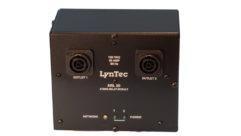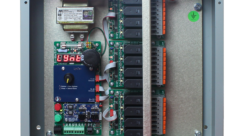EXAMINING our friend, the relay
Oct 1, 2000 12:00 PM,
Steve Filippini
In today’s world of integrated circuits and lightning-fast modes of communication, it is easy to overlook the ever-changing basic components that constitute a home automation and security system. Over the years, fuses have been replaced with thermal circuit-breakers. Terminal strips that once used small screws and blocks when securing wires have been replaced with pressure clips that require nothing more than inserting the ends of the lead into the proper slot. Heat-sink power supplies that dissipated energy from power transistors have been upgraded to switching power supplies that require less input to produce more output. Yet, despite all of these advancements in technology that ensure bigger and better systems, one component has essentially remained unchanged – the relay.
The relay is a simple device that requires an AC or DC current to flow through a tightly wrapped roll of copper wire around an iron core. When current flows through it, a magnetic field is created that pulls in a small metal plate. That plate is mounted with one or more metal brushes that are called “contacts.” These contacts are mated with other sets of contacts that are set apart from the moveable plate. The meeting of the moveable brush and its stationary plate-mate provide a dry-contact connection. Depending on the position of the contacts and the source attached to the mated contact, many customized applications can be achieved.
There are three common types of relays used in security applications – the single-pull-single-throw (SPST), the single-pull-double-throw (SPDT) and the double-pull-double-throw (DPDT). The SPST consists of only two contacts – the common and the mate. Typically, when the relay coil is dormant, the two contacts make a connection. When it is energized, the connection is broken. The SPDT has three contacts – a common, a normally open (N/O) connection and a normally closed (N/C) connection. This type of design is also referred to as a “Form C Contact.” The DPDT has six contacts. There are two isolated commons with their own pair of mates (N/O and N/C). There are more styles and designs out there to choose from, but for now, I will keep it to these.
Mechanical relays are not uncommon in the security field. One of the first security systems was a relay, a keyswitch, a bell and four lantern batteries. Commonly referred to as a “local bell” system, this configuration relied on the relay to latch into an alarm condition whenever a point of protection was violated. There are still many of these systems out there protecting businesses and residences.
Micro-relays are used in circuit boards to seize telephone lines for dialing out alarm messages, and in the old days, they provided the tickety-ticks for pulse dialing applications. They are also used in most peripheral detection devices, such as motion detectors and glass-break sensors. They even show up every now and then in fire-detection devices.
Relays can be used to isolate high levels of AC induction from a protection loop. When long runs of wire are routed near 110 V power wiring, some of the AC signal may bleed onto the cable. This is not always acceptable to many of the security systems on the market. If the AC induction is not properly bled off the cable, the system’s microprocessor may become unstable and not operate correctly. By routing the protection circuit through the relay’s coil with low-voltage power, you can use the relay’s contacts to react accordingly to the point of protection.
This same configuration can be used when trying to compensate for fluctuating high resistance on a protection loop. Some security systems have a small window of deviation when it comes to circuit current, and changes to the circuit’s resistance may result in false alarms. By isolating the circuit and using the relay’s contacts, any changes in the protection loop can be tolerated.
Depending on the security system, there are limitations on how many fire detection devices you can power off of the control. If there is a need for more devices than the specified number allowed, you can add an external power supply, run the devices on the supply and route the power through the relay contacts. The relay’s coil is then powered off the system’s fire circuit. That way, when the security system drops power to the fire circuit, the relay will open its contacts and reset the devices on the expanded fire loop.
When low-current sources are provided by the system during alarm conditions, and a higher current source is required, a relay can be powered off the control panel, and external power sources can be pumped through the contacts. I once worked for a manager that believed any problem a security system may have could be corrected by using a relay. I took that thought one step further and believed that any application dreamed up by our sales force could be accomplished by using a relay.
I was once at a home that used relays to turn on stereo loudspeakers whenever someone entered a room. A security infrared detector was positioned to activate at the first sign of room habitation. The internal security contacts would change state and provide power to a larger and more robust relay. The audio engineer had used a DPDT relay for each loudspeaker load. The left channel relay, for example, came in and connected to the two common terminals. The two N/O contacts were wired to the loudspeaker, and the two N/C contacts were wired to a load resistor to compensate for the missing load when the room was unoccupied. The engineer then added a small timer to the circuit to hold the contacts in place for 20 minutes or so when activated. That way, if the customer stopped moving or ceased to radiate body heat, the music would not immediately turn off.
Another application that used an isolated relay was for a customer who had a long walkway from the street to his front door. He had us install an infrared detector outside on the porch and had it aimed down the walkway. We then connected the infrared detector to his doorbell. That way, anyone approaching the home would trip the infrared detector and ring the doorbell. The first day we used this wiring scheme proved disastrous. The infrared detector went bad a few hours after we left and I had to return at night to stop the doorbell from ringing every few seconds. I replaced the detector with a better, more suitable model, and it worked fine.
Despite the careful steps in planning out an application with motion sensors and relays, we were not prepared for the service call at a recording studio several years ago. I was dispatched to the location to respond to an unknown complaint. When I arrived, the studio engineer played me a recent tape of a local band that had just finished recording their first demo. There was a constant clicking sound throughout a song. The engineer explained to me that the studio originally thought the clicks were the result of a bad sound mixing board. Because the board was built in England, the studio flew the designer out to the states to repair it. Imagine their surprise when they discovered that the clicks were from a micro-relay built into our security motion sensor. The sensitive mics picked up the motion sensor that had activated every time the drummer moved. Because drummers move a lot, the clicks were continuous. I removed the motion sensor and offered my sincere apologies.
Security systems have long since used open collector outputs to provide some of the same functionality as relays. An open collector is an electronic switch that provides a circuit path to ground when active. This is accomplished by connecting the emitter of the transmitter to a common or earth ground and the collector to the positive side of the circuit. In a non-alarm condition, the collector and emitter are not connected, thus the term “open collector.” When the control panel activates because of an alarm condition, the circuitry applies current to the base of the transmitter and closes the connection between the collector and emitter. Because these transistors are typically rated to handle only 80 milliamps to 100 milliamps, a relay is added to handle larger current loads. If a relay is powered from the open collector circuit, you need to add an IN4004 diode across the relay coil with the stripe on the positive side of the source. This diode is necessary to avoid possible damage to the circuitry when the relay coil is energized and then de-energized. As the magnetic field in the coil collapses, the current will try to flow back into the positive side of the circuit. If the reverse flow is large enough, it will spike the power source and damage the control panel.
Relays are also used in low-voltage lighting applications and X-10 lighting products that switch large loads of AC power. In low-voltage lighting, the on/off switches are data driven and when pressed, tell the control panel to change the state of one or more AC relay devices. That is why the familiar “click” that results from pressing one of these switches is heard from an attic or utility room and not from the light fixture.
The next time you hear that your security or home-automation system is state of the art, just remember that it is built around a little component known as the relay.








